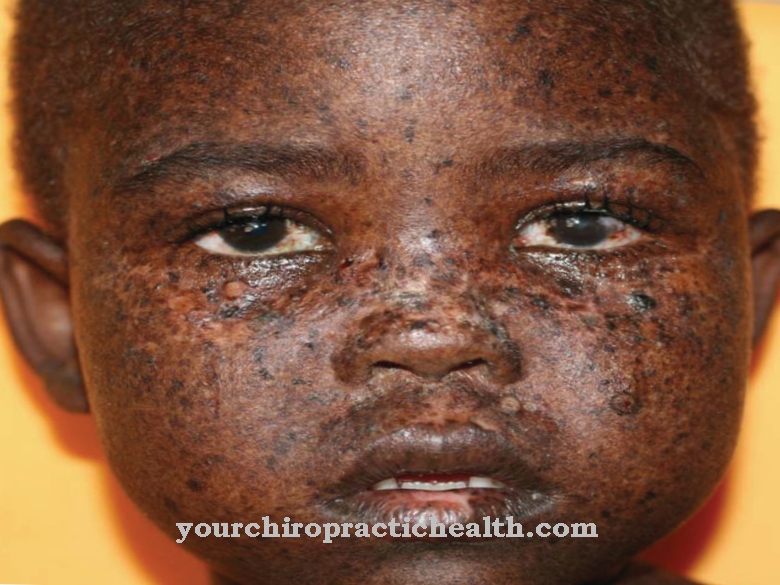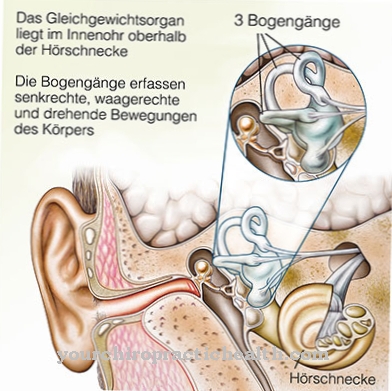The Still syndrome is a form of rheumatism that occurs in children. The disease affects the entire body, causing a fever, rash, and swelling of the lymph nodes, liver, and / or spleen. Three quarters of those affected are symptom-free as adults.
What is Still Syndrome?

© Tomsickova - stock.adobe.com
At the Still syndrome it is a rheumatic disease of children and adolescents under 16 years of age. Boys and girls get sick about equally often. Medicine also refers to it as systemic juvenile idiopathic arthritis (sJIA). The addition “systemic” indicates that the disease is not limited to individual body regions, but rather spreads to the entire organism.
When Frederic Still first described the syndrome named after him, the causes were still completely unclear (“idiopathic”) - even today there are only rough theories about its origin. In addition to Still syndrome, there are other variants of JIA; of all patients, around 10 to 20 percent suffer from the systemic form.
causes
Although there are various theories about the causes of Still syndrome, there is still a great deal of research needed to understand the mechanisms behind the development of the disease. Research is discussing both genes and environmental influences. One of the origins of Still syndrome deals with the immune system.
Certain genes may trigger an autoimmune reaction in which the body's defense system incorrectly turns itself against itself. This is indicated, among other things, by some symptoms of Still's syndrome; for example, it is typical of autoimmune diseases to swell the lymph nodes or develop a rash.
In addition, however, medicine also considers external influences as the cause. For example, she discusses to what extent an infection is a possible trigger. Parvovirus B19 appears to be very promising in this regard. It primarily affects people and, after successful infection, causes rubella. In this disease, the skin rash (exanthema) spreads over the face and trunk.
On the arms and legs, it only manifests itself on the extensor side. Fever and itching are other symptoms. Rubella today is a rare disease and usually does not have any serious consequences or complications. However, rubella infection promotes the occurrence of arthritis - the possible link between human parvovirus B19 and Still's syndrome.
Symptoms, ailments & signs
The affected child initially has a fever every day, after which at least one joint in the body becomes infected. The fever lasts for two weeks or more, and may swell up and down, but comes back every day. The joint inflammation shows up within the next six months. A salmon-colored rash can spread over the skin, which is unstable and has small spots.
The Still syndrome also has a very strong effect on the internal organs. In addition to the lymph nodes, the spleen and liver may also swell. The thin skin surrounding the organs (serositis), the heart (carditis), the iris and / or the ciliary body (iridocyclitis) may become inflamed. Furthermore, those affected may suffer from anemia.
Diagnosis & course of disease
Still syndrome usually begins insidiously between the ages of two and eight, often before the age of four. After the first fever, the joint inflammation manifests itself within a period of six months. The finger joints are often the first to become inflamed; medicine speaks of the "still hand" when the joints swell symmetrically in a spindle shape.
The disease is usually chronic; Three quarters of patients no longer suffer from the symptoms in adulthood. In the worst case, however, severe damage to the joints is the result. A detailed anamnesis is of great importance for the diagnosis. Doctors examine the blood and can find evidence of inflammation. X-rays of the potentially affected joints not only show how far the joint inflammation has spread across the body, but also how severe the destruction of the individual joints is.
Complications
Still syndrome leads to many different complaints. The affected children usually have a very high fever. Fatigue and exhaustion develop. There is also inflammation, which in most cases affects a joint. Several joints can also become inflamed. The children suffer from severe pain and swelling.
Because of the pain, there are also restrictions in movement and thus also in development. There are also discomforts on the skin, so that it is reddish in color and possibly covered by a rash. If Still's syndrome is not treated, the spleen and liver will also be irreversibly damaged. The child can eventually die from this damage.
The heart can also become inflamed and those affected often suffer from anemia. There are no particular complications in the treatment of Still syndrome. The inflammation can be treated with the help of medication. It also relieves pain and swelling. However, various therapies are still necessary to restore full movement of the affected joints.
When should you go to the doctor?
If children show health impairments or abnormalities, they should always be presented to a pediatrician. During a control visit, the severity or extent of the particularities can be discussed and clarified. Lymph swellings, fever or changes in the appearance of the skin should be examined and clarified. If deformations or irregularities are noticed on the upper body, a doctor is also required. Inflammation or impairment of joint activity, impaired locomotion and a decrease in physical performance must be presented to a doctor.
If the child shows general behavior problems, a tearfulness or an apparently baseless aggressive demeanor, they need help. In many cases, physical irregularities are behind this occurrence. Listlessness, listlessness or irritability are further signs of an existing health disorder. A doctor should be consulted if the child's play instinct is reduced, sleep disorders or withdrawal behavior are evident.
Spots on the skin that spread or develop in other parts of the body are considered unusual. Particularly warm joints or a sensation of heat in the body are further indications of the organism of an existing disease. Swelling in the hands or feet is unusual and should be investigated further. If the child has a fever for several days, action is required. Although the increased body temperature regulates itself during the day, a repeated occurrence is a sign of illness.
Therapy & Treatment
When treating Still syndrome, doctors usually prescribe anti-inflammatory pain relievers known as nonsteroidal anti-inflammatory drugs (NSAIDs). They alleviate symptoms and are designed to stop joint destruction. In contrast to the previously widely used steroidal anti-inflammatory drugs, NSAIDs have fewer side effects. Medicine has been using NSAIDs since the 1950s.
Non-selective NSAIDs or COX-1/2 inhibitors include aspirin, ibuprofen, and indomethacin. Cyclooxygenases (COX) are enzymes that play a central role in the inflammatory response. Medicines that inhibit the biocatalysts accordingly interrupt the inflammatory reaction or at least dampen it. Cyclooxygenases come in two forms in the human body; however, only COX-2 is crucial for the treatment of Still's syndrome and other rheumatic diseases.
If an NSAID inhibits both cyclooxygenases, more side effects occur. In specific individual cases, however, a non-selective NSAID can be more useful; Only the attending physician can decide which drug offers the greater advantages. Drugs that only inhibit COX-2 have been on the market since 1999. Examples of selective NSAIDs or COX-2 inhibitors are rofecoxib, parecoxib, etoricoxib and celecoxib.
In addition to NSAIDs, other drugs can also be considered, including glucocorticoids and, from a preparation-specific age, biologicals. Ergotherapy and physiotherapy complement the treatment. Children who suffer severely from the effects of Still's syndrome or who show behavioral problems, unusual anxiety or symptoms of depression should also receive psychological or psychosocial support. With severe and / or systemic diseases such as Still syndrome, those affected are often psychologically stressed.
prevention
As the exact causes of Still's syndrome are still unknown, targeted prevention is currently not possible. If the theory is confirmed that the human parvovirus B19 causes the disease, vaccinations could bring progress.
Aftercare
Still syndrome requires extensive follow-up care. Patients with Still syndrome should contact their family doctor. The relapsing progression of the disease must be monitored by a doctor. If you have a high fever and severe joint pain, your doctor may prescribe a pain reliever or other medication. After recovery, the doctor will inform about the correct tapering of the drug.
Depending on which preparation has been prescribed, any side effects must also be clarified. In the case of chronic complaints, Still's disease must be regularly examined by a doctor, as the disease poses a continuing risk. Comprehensive medical treatment is necessary, especially for young children.
Follow-up care for Still's disease is carried out by the family doctor or the responsible specialist who was already involved in the treatment of the syndrome. Usually this is an internist or an orthopedic surgeon. Further contacts are general practitioners or physiotherapists if the joint pain persists after recovery.
Still syndrome occurs mainly between the first and fourth year of life. During this period, a doctor should be consulted if the patient is predisposed so that the disease can be clarified or excluded. The pediatrician is usually also involved in follow-up care.
You can do that yourself
To support the recovery process, relatives should create optimal conditions for their offspring to strengthen the immune system. The disease mainly affects children and adolescents. Since they are naturally unable to initiate sufficient self-help measures, they are dependent on the help of relatives and adults.
They are obliged to inform the sick child about the health disorder and the complaints. Comprehensive information about the further course and the avoidance of risk factors is necessary. In addition, an optimal environment for the patient must be created through nutrition, the organization of everyday life and support for the psyche. A balanced and vitamin-rich food supply helps the organism to deal with the disease. Adequate exercise and the promotion of vitality are also important in order to improve the overall situation.
Obesity should be avoided and the child should not be in any environment where smoking is taking place or where excessive alcohol is consumed. The child's clothing should be adapted to the needs of the body. A sufficient supply of heat is particularly important so that no complications occur or existing complaints increase. If you have a fever, you should ensure that you drink enough fluids. The normal daily requirement must be increased in these cases.

.jpg)
.jpg)









.jpg)



.jpg)










.jpg)
